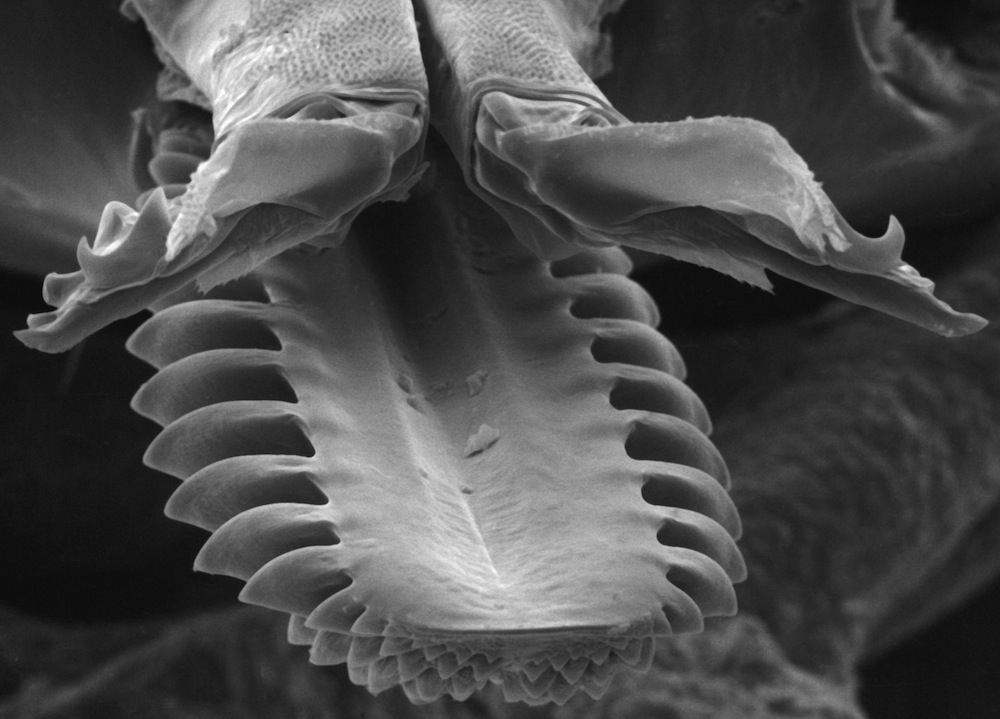
A tick sucking blood from a victim has been caught in action on video, in all its gory glory.
The new tick-sucking video, described today (Oct. 29) in the journal Proceedings of the Royal Society B, reveals for the first time the gruesome method that ticks use to anchor to the skin and insert their bloodsucking machinery.
It turns out the parasites don't use a drilling, sawing or cutting motion to get the job done. Instead, they use mouthparts made of a pair of telescoping structures to pierce the skin, and then in a motion like the breaststroke pull the skin over a plate on their mouth that's armed with barbs. [Ick! 5 Alien Parasites and Their Real-World Counterparts]
Anchored pests
Unlike how mosquitos bite, ticks often stay attached to a host for days to a week, filling up with blood until they are engorged enough to lay eggs or enter the next phase of their life cycle.
"Mosquitos or other biting flies stay on the host for a very short time," said study co-author Dania Richter, a parasitologist at Charité - Universitätsmedizin Berlin. "The tick has a much different challenge, which is to be in there to stay."
To remain attached unobtrusively, ticks insert pain relievers, and anti-clotting and anti-inflammatory substances at the site of the puncture. But they also must anchor their bodies firmly to the puncture site without causing much pain. Some ticks use cement to anchor in place, but scientists aren't sure how the Ixodes ricinus tick, which is widespread throughout the temperate zones of Europe, stays stuck.
Get the world’s most fascinating discoveries delivered straight to your inbox.
In the 1930s and 1940s, many scientists proposed several ways ticks accomplish this gory task, but all of them relied on microscope images and guesswork. Some argued that ticks used a sawing motion, while others said they were drilling through the skin or pushing at it. No one could say for sure.
Caught on tape
Richter and her colleagues took a closer look at the repulsive process.
The team captured video of I. ricinus as they pierced the ears of euthanized hairless mice. They also took several highly detailed scanning electron and confocal microscope images of the bloodsucking parasites' mouthparts and combined that information with the video. [Video - Bloodsucking Tick in Action]
Once ticks are firmly anchored, it's quite difficult to dislodge them, and their hypostome often gets broken and remains in the skin in the process (but doesn't cause harm). Given that ticks are so firmly fixed, scientists are still unclear exactly how they drop off voluntarily when they've had their fill of blood, Richter said.
Follow Tia Ghose on Twitter and Google+. Follow LiveScience @livescience, Facebook & Google+. Original article on LiveScience.

Tia is the editor-in-chief (premium) and was formerly managing editor and senior writer for Live Science. Her work has appeared in Scientific American, Wired.com, Science News and other outlets. She holds a master's degree in bioengineering from the University of Washington, a graduate certificate in science writing from UC Santa Cruz and a bachelor's degree in mechanical engineering from the University of Texas at Austin. Tia was part of a team at the Milwaukee Journal Sentinel that published the Empty Cradles series on preterm births, which won multiple awards, including the 2012 Casey Medal for Meritorious Journalism.


